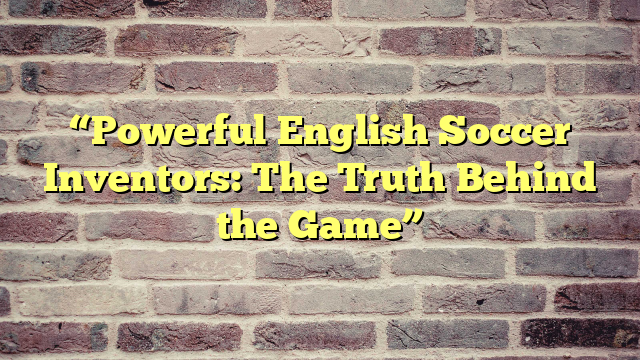Focus Keyword: English Soccer Inventors
Subheadings:
1. Introduction: The Evolution of English Soccer
2. The Early Pioneers: Charles Alcock and Ebenezer Cobb Morley
3. The Revolutionary Invention: The Football Association
4. Innovation in the Field: The Contributions of James Richardson Spensley
5. The Creation of Modern Tactics: Herbert Chapman and the W-M Formation
6. The Rise of Women in Soccer: The Impact of Nettie Honeyball
7. The Legacy Continues: The Influence of English Soccer Inventors Today
Introduction: The Evolution of English Soccer
Soccer, or football as it is known in most parts of the world, is undeniably the most popular sport in the world. It has captured the hearts and minds of millions, and its popularity continues to grow with each passing year. The origins of this beautiful game can be traced back to ancient civilizations, but it was the English who truly revolutionized and shaped the modern version of the sport. From the invention of the Football Association to the creation of modern tactics, English soccer inventors have played a crucial role in shaping the game we know and love today. In this article, we will explore the truth behind the powerful English soccer inventors and their contributions to the game.
The Early Pioneers: Charles Alcock and Ebenezer Cobb Morley
The history of English soccer dates back to the 19th century when the game was played in public schools and universities. However, it was Charles Alcock and Ebenezer Cobb Morley who are credited with laying the foundation for the modern game. In 1863, Alcock, a prominent sportsman, and Morley, a lawyer, came together to form the Football Association (FA). This was a revolutionary move as it brought together various clubs and schools to establish a standard set of rules for the game. This marked the beginning of organized and competitive soccer in England.
The Revolutionary Invention: The Football Association
The formation of the Football Association proved to be a turning point in the history of soccer. It not only provided a platform for clubs and players to compete against each other but also gave birth to a code of conduct and fair play. The first set of rules, known as the “Laws of the Game,” were drawn up by Ebenezer Cobb Morley and were adopted by the FA. These rules laid the foundation for the modern game and continue to be the basis for the rules of soccer today.
Innovation in the Field: The Contributions of James Richardson Spensley
James Richardson Spensley was a Scottish doctor who moved to England in the late 19th century. He was a passionate soccer enthusiast and is credited with introducing several innovations to the game. Spensley is most famous for his contribution to the development of goal nets. Before his invention, a goal was scored when the ball passed between two posts without touching the ground. However, Spensley introduced the concept of goal nets, which made it easier to determine if a goal had been scored. This invention revolutionized the game and is still used in soccer today.
The Creation of Modern Tactics: Herbert Chapman and the W-M Formation
Herbert Chapman is considered one of the most influential figures in the history of English soccer. He is credited with revolutionizing the tactics of the game and introducing the “W-M formation.” This formation consisted of four defenders, three midfielders, and three forwards, and was the precursor to the modern 4-4-2 formation. Chapman’s tactics proved to be highly successful, and he went on to win multiple league titles with his team, Arsenal. His innovative tactics continue to be used by managers and coaches all over the world.
The Rise of Women in Soccer: The Impact of Nettie Honeyball
Nettie Honeyball was a trailblazer for women in soccer. In 1894, she founded the British Ladies’ Football Club, which was the first-ever women’s soccer team in England. Honeyball believed that women deserved the right to play soccer and paved the way for future generations of female players. Her team’s success and popularity helped to break down gender barriers and opened doors for women in the world of soccer. Today, the Women’s Super League in England is one of the most competitive and respected women’s soccer leagues in the world, and it all started with Nettie Honeyball’s vision and determination.
The Legacy Continues: The Influence of English Soccer Inventors Today
The contributions of English soccer inventors continue to shape the game in the present day. The FA continues to be the governing body for soccer in England and is responsible for organizing major tournaments such as the Premier League and the FA Cup. The “Laws of the Game” are constantly updated and revised to keep up with the changing dynamics of the sport. The W-M formation, introduced by Herbert Chapman, is still widely used by teams all over the

